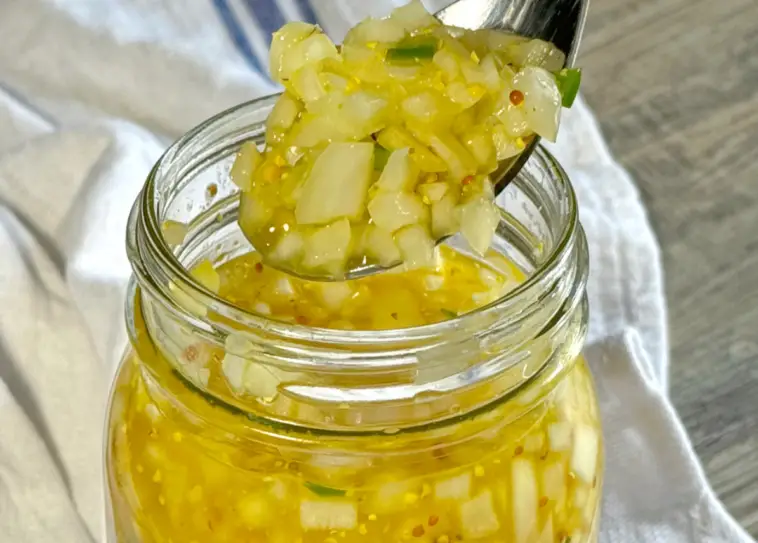The 19th Century Onion BBQ Chutney brings forth a taste of culinary history with its robust flavors and traditional preparation methods. Rooted in the rich tapestry of American cooking, this chutney reflects the era’s reliance on preserving ingredients and enhancing flavors through spices and vinegar. In this article, we’ll explore the origins of this recipe, guide you through making it step-by-step, offer insights into its nutritional profile, suggest modern variations, and provide tips for serving and storing.
Historical Origins
Chutneys have a long history across cultures, with variations found in Indian, British, and American culinary traditions. In the United States, especially during the 19th century, chutneys were valued for their ability to preserve fruits and vegetables while adding depth of flavor to meals. The combination of onions, spices, and vinegar in this chutney likely emerged as a way to utilize readily available ingredients and enhance the flavors of simple dishes.
Recipe: 19th Century Onion BBQ Chutney
Ingredients:
- 2 large onions, finely chopped
- 1 to 2 hot peppers (e.g., jalapeño), roughly chopped
- 2 tablespoons packed light brown sugar
- 1 tablespoon celery seed
- 1 tablespoon ground mustard
- 1 teaspoon ground turmeric
- 1 teaspoon ground black pepper
- 1 teaspoon kosher salt
- 1 cup white or apple cider vinegar
Instructions:
- Prepare Ingredients:
- Finely chop the onions and roughly chop the hot peppers. Adjust the number of peppers based on your desired level of spiciness.
- Cooking the Chutney:
- In a large, heavy-bottomed saucepan, combine the chopped onions, hot peppers, brown sugar, celery seed, ground mustard, turmeric, black pepper, salt, and vinegar.
- Simmering:
- Place the saucepan over medium heat and bring the mixture to a simmer, stirring occasionally to dissolve the sugar and combine the ingredients.
- Cooking Process:
- Once simmering, reduce the heat to low and let the chutney gently simmer for about 30-40 minutes, or until the onions are tender and the mixture has thickened to a chutney-like consistency. Stir occasionally to prevent sticking.
- Adjust Seasoning:
- Taste the chutney and adjust seasoning if needed. Add more salt, pepper, or sugar according to your taste preferences.
- Cooling and Storage:
- Remove the saucepan from heat and let the chutney cool to room temperature.
- Transfer the chutney to clean, sterilized jars or containers. Seal tightly and store in the refrigerator.
Historical Context
During the 19th century, preserving food was essential due to limited refrigeration and the need to sustain households through seasons with varying crop availability. Chutneys, with their vinegar content, served as a way to extend the shelf life of perishable ingredients like onions and peppers while adding piquancy to meals. This practice aligned with the era’s emphasis on resourcefulness and practical cooking techniques.
Modern Adaptations and Variations
While the 19th Century Onion BBQ Chutney recipe stays true to its historical roots, modern adaptations allow for creativity and personalization:
1. Sweet and Spicy Twist
- Ingredients: Add a tablespoon of honey or maple syrup for a touch of sweetness, balancing the heat from the peppers.
2. Smoky Flavor Infusion
- Ingredients: Incorporate smoked paprika or chipotle powder to add a smoky depth to the chutney, perfect for pairing with grilled meats or vegetables.
3. Fruit Infusion
- Ingredients: Experiment with adding diced apples or dried fruits like raisins or apricots during the simmering process for a fruity twist.
Nutritional Insights
The nutritional profile of the 19th Century Onion BBQ Chutney varies based on ingredient proportions and serving size. As a condiment, it contributes to dishes primarily through its flavors rather than significant nutrient content. Here’s a general breakdown per serving:
- Calories: Approximately 50-70 kcal
- Carbohydrates: 10-15g
- Sugars: 7-10g
- Fat: Negligible (depends on added fats like butter)
- Protein: Minimal
Serving Suggestions
1. Pairing with Meats
- BBQ Complement: Serve alongside grilled or smoked meats such as chicken, pork ribs, or brisket for a tangy contrast.
2. Cheese Board Addition
- Cheese Platter: Use as a condiment on a cheese board with aged cheddar, gouda, or blue cheese for a savory-sweet balance.
3. Sandwich Spread
- Sandwich Enhancer: Spread on sandwiches or wraps to elevate flavors, especially with roasted vegetables or grilled chicken.
Frequently Asked Questions (FAQs)
Q: How long can 19th Century Onion BBQ Chutney be stored?
A: Properly stored in a sealed container in the refrigerator, the chutney can last for up to one month.
Q: Can I use different types of vinegar?
A: Yes, you can substitute white vinegar with apple cider vinegar, red wine vinegar, or even balsamic vinegar for different flavor profiles.
Q: Is this chutney spicy?
A: The level of spiciness can be adjusted by varying the amount of hot peppers used. Start with a small amount and add more to suit your taste preferences.
The 19th Century Onion BBQ Chutney offers a delightful glimpse into historical culinary practices, showcasing the ingenuity of using simple ingredients to create complex flavors. Whether enjoyed as a condiment, marinade enhancer, or gourmet spread, this chutney encapsulates the essence of traditional American cooking. By following the provided recipe, experimenting with variations, and understanding its historical context, you can savor this timeless dish and share its rich flavors with family and friends.
This detailed article not only provides a step-by-step guide to making the 19th Century Onion BBQ Chutney but also explores its historical roots, nutritional aspects, modern adaptations, and practical serving suggestions, ensuring a comprehensive understanding and appreciation of this classic dish.


